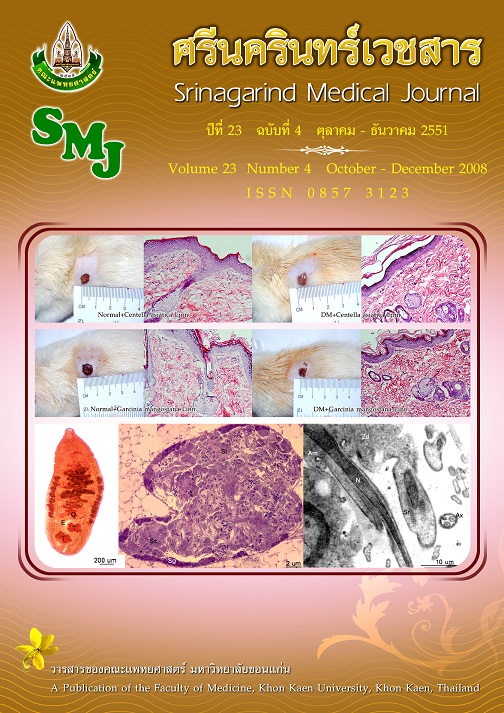Adverse Drug Reaction Monitoring to Antiepileptic Drugs by Patient Self Reports
Abstract
Background: Spontaneous reporting of suspected ADRs is depending on voluntary reporting by health professionals. Under-reporting is a major problem. Patient self-reporting of ADRs might be a new useful and feasible method of ADR monitoring which would result in an increased reporting rate of ADRs.
Objective: To determine the frequency of the symptoms identified by patients as perceived ADRs and to evaluate the accuracy of patient attribution of reported symptoms to antiepileptic drugs.
Method: Questionnaires were distributed by researcher at the Srinagarind Hospital during July 16 to September 16, 2007 and by post to the outpatients during October 1 to December 30, 2007.
Design: Retrospective descriptive study
Setting: Srinagarind Hospital, Khon Kaen University
Populations: Patients of Outpatient Department who were prescribed with phinytoin, carbamazepine and valproie acid during July 1, 2006 to September 30, 2007.
Results: Forty-four percents response rate was obtained (170/384) and 216 respondents were collected data at the Srinagarind Hospital with 358 (n=386) respondents (97.2%) reporting at least one symptom. The majority of patients were female (52.3%), with the mean age of 41.13±16.2 years. Thirty-six percent of respondents reported fewer than five symptoms. Number of underlying diseases, number of concomitant drugs and gender were significantly associated with frequency of reporting at least one symptom (p=0.041, p=0.032 and p=0.004, respectively). Dizziness was the most frequent symptoms reported in phenytoin-treated patients (43.4%), loss of memory was most frequent symptoms reported in carbamazepine and valproic acid treated patients (32.7% and 39.6%, respectively). The majority of symptoms were classified as being possibly (45.5% of all symptoms reported) and all reported 63.3% symptoms related to drug studied. Age, level of education and number of symptoms were significantly associated with identify symptoms potentially caused by study drugs (p=0.033, p=0.046, and p=0.000 respectively).
Conclusion: This study indicated that patient perceptions of potential ADRs are relevant and patient self-reporting are an useful additional method for examining the occurrence of ADRs.
Keywords: Adverse drug reaction, antiepileptic drugs, patient self-reporting




